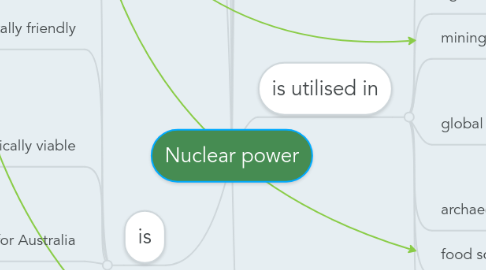
1. is
1.1. sustainable
1.1.1. as it "meets the needs of the present without compromising the ability of future generations to meet their own needs"
1.1.2. as it is an enduring energy source for the future
1.1.3. as spent uranium fuel is reusable, meaning reduced waste and disposal volumes
1.2. environmentally friendly
1.2.1. current nuclear energy avoids 2.1 billion tonnes of CO2 emissions/year
1.2.2. nuclear power plants require less land area than other energy options
1.3. economically viable
1.3.1. unlikely to run out of Uranium
1.3.2. nuclear power plants last 20-30 years longer than coal, gas & other renewables
1.4. the most suitable electricity source for Australia
1.4.1. without Nuclear power, Australia may not reach its goal of net zero emissions by 2050
1.5. safe
1.5.1. 10 times safer than coal (accidents)
1.5.2. 600 times safer than coal (pollution)
1.5.3. zero nuclear related deaths have occurred in 60 years, since the beginning of the US nuclear power program
1.5.4. has prevented 1.8 million net deaths between 1971-2009
1.6. reliable in its delivery
1.6.1. fast ramp-up
1.6.2. grid stability
1.6.3. renewables (wind, hydro, solar) are not advancing fast enough
1.6.4. 80% of France's electricity is nuclear
2. can benefit the environment as it
2.1. does not produce the 30% CO2 that has diffused into the ocean - carbonic acid
2.1.1. making ocean water more acidic, coral bleaching, warmer temperatures
2.2. does not produce the 25% CO2 that plants have absorbed
2.2.1. "baking" soil & stressing the plants, increased bushfires
2.3. does not produce CO2 to warm the atmosphere
2.4. could reduce carbon emissions that have reached a maximum of 440ppm this year
3. results in less harm to humans than
3.1. everyday radiation (buildings, cosmic rays, medical equipment)
4. provides
4.1. cleaner air
4.2. clean (no CO2 or methane) carbon-free electricity
4.3. no greenhouse gases
4.4. less emissions than solar
4.5. the lowest impact on the environment (water, land & habitats)
4.6. heat for desalination plants
4.7. fuels & technologies for space exploration
4.8. effective replacement of fossil fuel electricity
5. is utilised in
5.1. health
5.1.1. nuclear imaging
5.1.1.1. MRIs & X-rays
5.1.2. hospitals & laboratories
5.1.3. sterilisation of bone & equipment
5.2. agricultural industries
5.3. mining & industrial
5.4. global military organisations
5.4.1. US, Russian, French, Indian & Chinese Navy
5.4.1.1. Nuclear powered Submarines, aircraft carriers & naval surface vessels
5.4.2. all with excellent safety records
5.5. archaeological research
5.6. food science, safety & food insect control
5.7. 10.8% of the World's electricity production in 2012
6. is in Australia
6.1. Lucas Heights reactor (Sydney)
6.1.1. which
6.1.1.1. is 1 of 70 reactors in the world capable of producing health related services
6.2. but isn't utilised to its full potential
6.2.1. and has some negative public perceptions
6.3. and 28 other countries (2011)
7. despite taking approx 20 years to construct
7.1. nuclear power plants emit one-tenth to one-twentieth less CO2 emissions over its lifetime than a fossil-fueled plant
7.2. "is the cheapest & best option to meet the greenhouse gas abatement"
7.3. the worst nuclear disasters are not as bad as the worst climate change disasters
7.4. current consumption rates should last 80 years, however more research and improvements of extraction technology will, at a minimum, double this figure
7.5. the power plants are being built to last up to 60 years
7.6. it will cost approx 40ppm whilst in the construction phase
7.6.1. the environment is still better off with this, than no nuclear at all
